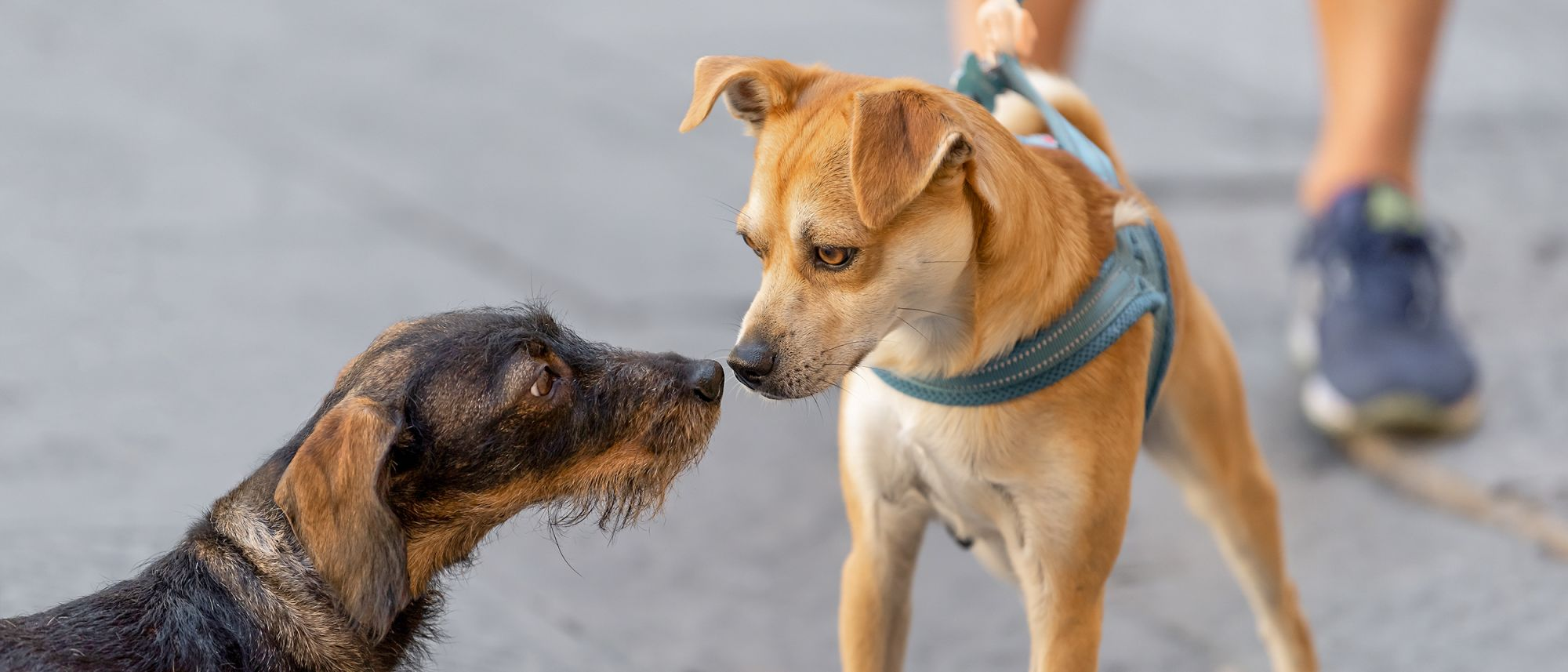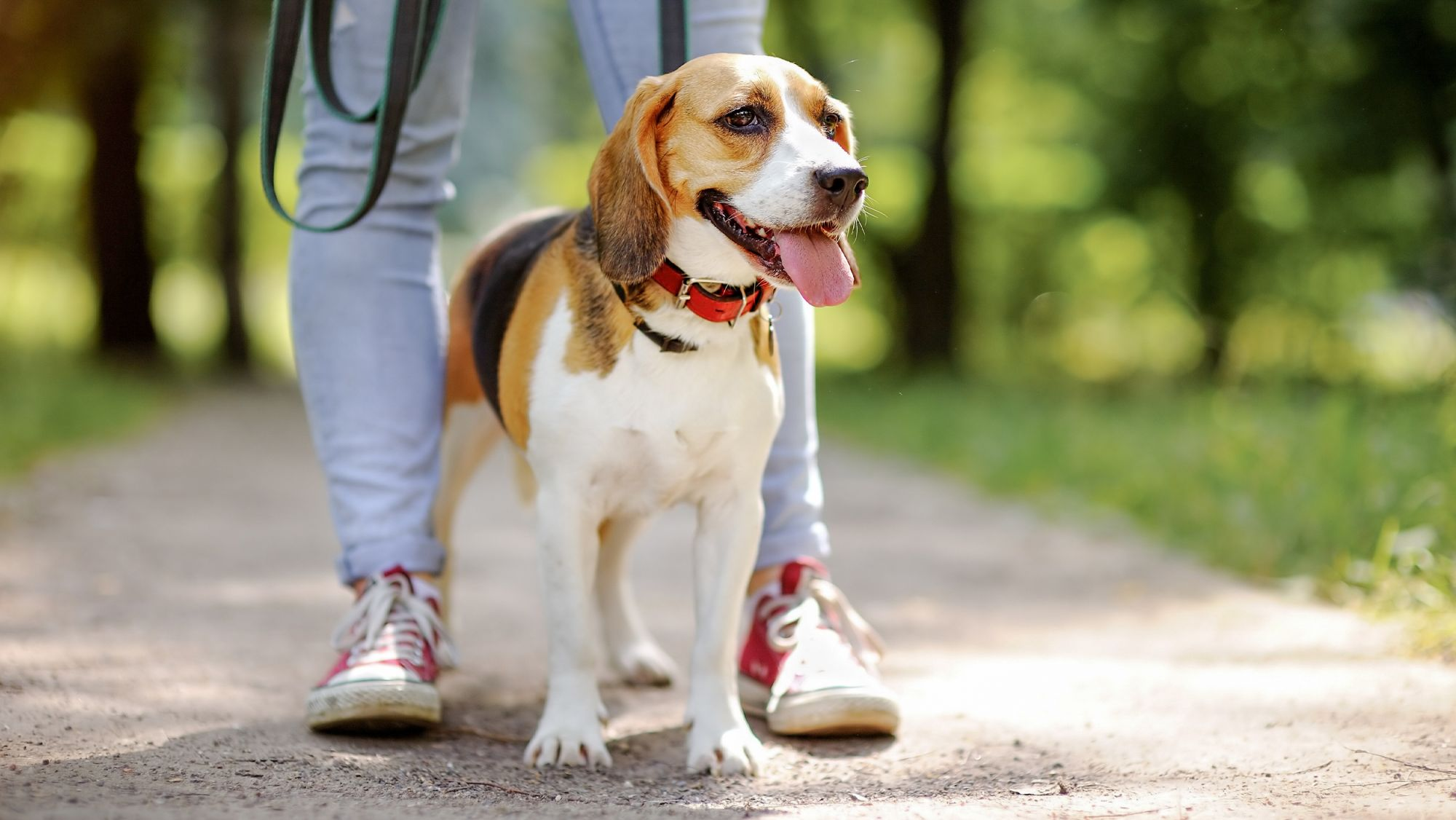How to socialise a dog after a lockdown

During the pandemic, people will have been staying at home for longer periods than usual. As a result, some people may have decided to purchase or adopt a puppy or dog. While all that extra time together can help strengthen the bond you share and make training simpler, it does mean there could be fewer opportunities for exploring and experiencing the world outside.
Similarly, dogs that were previously socialised may find situations have changed during the lockdown – encountering more joggers and cyclists on their walks, for example. Dogs will also likely be aware of people wearing a mask, which considerably changes the visual signs they often use to recognise expressed emotions.
That’s why, as normal life begins to resume, you should try to familiarise or reintroduce them to different experiences through dog socialisation and familiarisation training.

Why is dog socialisation important?
Socialisation is a process of learning in which your puppy is introduced to the world. Any new experience you share with them is part of this socialisation and contributes to their ability to master communication. It could be meeting a new person or another dog, getting in a car, hearing a hairdryer, or just going to a new location.Appropriate socialisation helps them to relax and enjoy life, equips them with the resilience to cope well with the huge variety of experiences and events they will encounter and enables them to become rewarding pets.
The main socialisation period occurs during the first few weeks of your puppy's life, however, it's important to continue socialisation and familiarisation even when they're an adult dog. Without socialisation, a dog may become fearful or even aggressive in unfamiliar situations.
When should I begin dog socialisation training?
Dogs are at their most receptive when they’re puppies, aged between 3 and 14 weeks. During this period, they’re quick to form attachments with others and are particularly sensitive to their environment. Your veterinarian can provide the best advice regarding when your puppy is ready for socialisation (based on their age and vaccinations).While these early encounters play a huge role in a dog’s future emotional balance, dog socialisation doesn’t end at 14 weeks. They will keep learning throughout their life and their reactions to familiar situations may change – a young dog may be comfortable being in a car at first but a negative experience may make them anxious later on.
Likewise, adult dogs who were under-socialised as puppies can learn new behaviours and become comfortable in previously stressful situations. However, it does require a different approach to socialising puppies.
How to socialise a puppy
Your veterinarian can provide the best advice regarding when a puppy is ready for socialisation (based on their age and vaccinations status) and you can then build on the socialisation basics taught by the puppy's mother.The aim is to expose your puppy to as many new sensations as possible while they’re still under 14 weeks; to let them see, hear, touch and smell the world around them.
Each new interaction they have with a dog, a person, or within their environment, will act as a reference point in their later life. The more positive experiences they have as a puppy, the more comfortable they’ll be as an adult.
But negative experiences will have a lasting impact too, so just like you would with an older dog, you should socialise them carefully by constantly watching their behaviour during an experience and managing their response.
If you've been unable to take your puppy outside as often as you'd like, due to the lockdown, you might begin by carrying them around outside, visiting a friend’s home (if allowed), or interacting with dogs you know are fully vaccinated and well-behaved.
Social distancing does make puppy and dog socialisation harder than before, but you can still observe the world together and interact with people and other dogs from a safe distance.
Always try to pace your socialisation training to suit your puppy’s comfort level – some have innate behaviours that make them naturally anxious. Ask your vet for individual advice about your puppy.

Socialising adult dogs
Unfortunately, not every dog will be properly socialised as a puppy.You may have adopted an older dog who was always kept inside, or perhaps your puppy was too ill to explore the world when they were young. You may even have been trapped indoors with your puppy during a lockdown.
Whatever the reason, if your dog misses that early window, you’ll find introducing unfamiliar experiences to them more challenging once they’re older. But it’s certainly still possible for your dog to progress with some patience and a slow and steady approach.
Social anxiety in dogs
If your dog becomes nervous or aggressive when other dogs or people are around, perhaps barking or looking for an opportunity to escape, it may be a sign that they need to be socialised.You may also find new behaviours develop over time or appear with a change in routine. A dog adopted during the pandemic will have grown used to you being around and may experience separation anxiety when they’re left alone. They may also have grown cautious of other dogs after so much time indoors. Learn more about separation anxiety in dogs here.
How to socialise an older dog
It’s important to be realistic when socialising adult dogs. If they missed out as a puppy, they’ll be starting from a disadvantage and it may not be possible to make them comfortable with everything they encounter.Depending on your dog’s background, your goal might just be to introduce enough stimuli so they can feel safe and secure in their immediate environment and not the entire world at large.
The key thing to remember is not to rush an older dog. They won’t absorb new experiences like a puppy, so you must work at a pace that suits them.
You also should consider if they’re in any pain (e.g. arthritis) or have a mental impairment that will make socialisation difficult for them. If you think this is the case, do not hesitate to talk to your vet who can provide some advice.
The best way to begin is to find an environment in which your dog is already comfortable, and slowly progress from there. For example, if you’re trying to introduce friends and family, have them approach your leashed dog slowly and one at a time, keeping their voices low and calm. Let them give your dog toys and if they show any anxiety, end the session and try another time. It's important to finish a socialisation session positively, so remember to bring toys and treats.
Encouragement, positivity, and patience will play a big role in your dog’s socialisation – as will rewards! Any time they make progress or try to conquer their fears, reward them with praise and their favourite toy or treat. Just remember to limit the number of treats you give and reduce the size of their main meals to balance their food intake.
Socialising adult dogs can take a long time, and you may encounter setbacks along the way. Don't be discouraged though, as the long term benefit to both you and your dog will be worth the time and effort. Please always consult with your veterinarian as they are the best resource to support you regarding socialising your puppy or dog.
Like & share this page